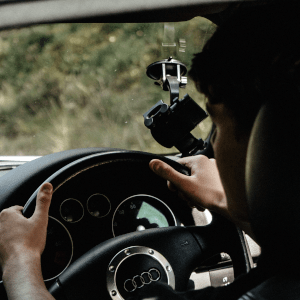 America’s roads can be a dangerous place for drivers, especially inexperienced drivers. There are plenty of hazards, like dangerous roadway conditions and other drivers. By knowing these tips for first-time drivers, new drivers can rest assured they’re safer than they were before reading the tips.
America’s roads can be a dangerous place for drivers, especially inexperienced drivers. There are plenty of hazards, like dangerous roadway conditions and other drivers. By knowing these tips for first-time drivers, new drivers can rest assured they’re safer than they were before reading the tips.
This article will cover driving tips for new drivers. New drivers need to remember tenets of defensive driving such as knowing all the rules, not exceeding the speed limit and maintaining their vehicles. By learning these aspects of defensive driving, new drivers can learn how to stay safe on the road.
1. Know The Rules Of The Road
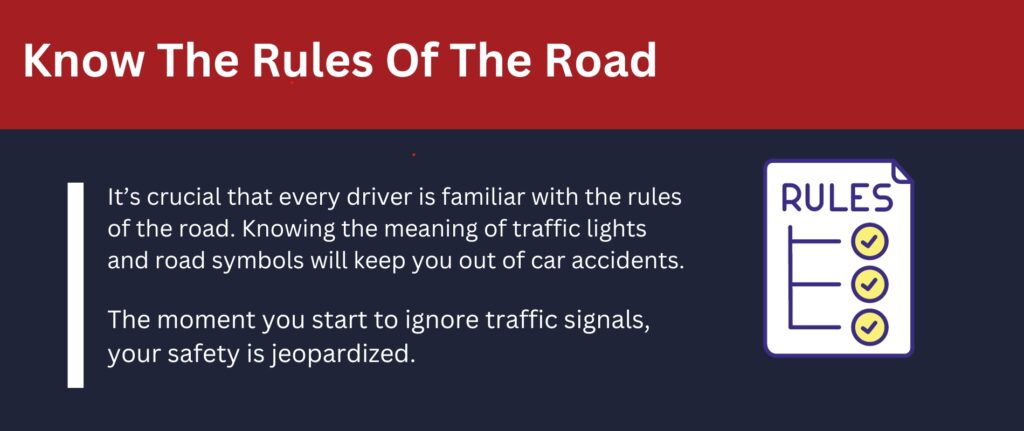
Perhaps the most important things regarding how to become a good driver is to know the rules of the road. Traffic laws are designed to keep everyone safe, so knowing and obeying them is the most important thing a good driver can do to stay safe.
Teen drivers, or any new drivers, for that matter, should start their journey towards obtaining a driver’s license by going through driver’s education. Driving lessons will teach you how to be a safe, responsible driver.
Once you know the rules of the road, like using the far left lane to pass and waiting until the light turns green to enter an intersection, and can pass a driving test, safe driving will involve obeying those rules, road signs, traffic signals, etc. If you start ignoring traffic signs, ignoring rules like speed limits or ignoring rules about changing lanes properly, car accidents could result.
2. Take It Slow
Another one of the most important tips for first-time drivers is to always obey the speed limit.
Young drivers are more likely to floor the gas pedal and exceed the speed limit. However, when you speed, the odds that you get in an accident increase. In addition, if you are a new driver, you should be aware that if you’re in an accident, the accident will be more severe the faster you’re going, and this could lead to severe injuries or even death.
One thing an experienced driver is likely to be able to tell new drivers is that driving more slowly gives you more time to hit the brakes and avoid an accident. If you’re in an accident, however, it’s often worth hiring a car accident attorney to ensure you’re compensated properly.
3. Adjust Your Vehicle
There is a reason why certain parts of your vehicle are adjustable: because driving is at its safest when those parts are adjusted to the individual driver. Make sure your steering wheel is adjusted properly, your driver’s seat is adjusted to your specific build and height, you’re sitting comfortably, etc. Make sure your rearview and side mirrors are at the proper angle so you can see other cars with them when you need to.
Adjusting your vehicle properly will help with both safety on the road as well as comfort.
4. Wear Your Seatbelt
Wearing your seatbelt dramatically increases your chances of surviving a serious car accident. Never neglect to wear your seatbelt.
- An estimated 14,955 lives were saved by seat belts in passenger vehicles in 2017
- While about 90 percent of Americans wear seat belts, about half of those killed in passenger vehicle accidents aren’t wearing a seat belt
5. Maintain Your Vehicle
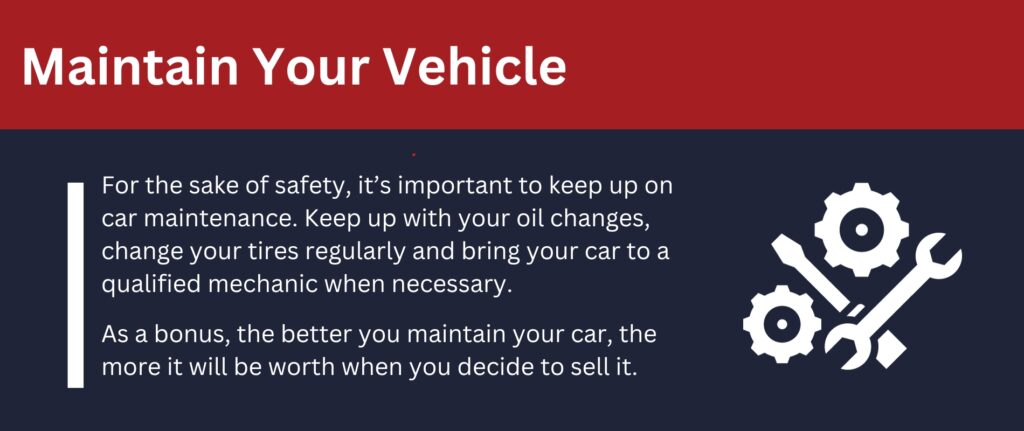
One important aspect of driving safely is making sure your vehicle is properly maintained. An improperly maintained vehicle is not a safe vehicle.
Make sure your brakes are always working properly. A vehicle without functional brakes is not a safe vehicle.
Make sure to keep up with oil changes. If your vehicle breaks down on a busy highway at high speeds, it could create a very dangerous situation.
Make sure your tires are changed when they need to be. Old, worn tires can create a dangerous lack of traction which can cause a serious car accident.
6. Practice On Familiar Roads
When you are first learning how to drive and developing your driving abilities, it is best to stick to roads you’re familiar with which feature low speeds and low amounts of traffic. This will minimize your chances of getting in an accident while you are learning how to be a safe driver.
Once you become very comfortable with driving on roads like these, you can then switch your route up and tackle other roads.
7. Don’t Overthink Driving

Overthinking driving can be dangerous – don’t do it.
Some drivers worry about what the drivers of other vehicles think about them. For example, some people worry if they’re inconveniencing others by driving too slowly, or if others will somehow think less of them if they drive too slowly. Don’t worry about what the other driver on the road with you thinks. Stick to driving as safely as you can, regardless of what others on the road think about you.
One way to avoid overthinking driving is to ensure that you are thoroughly familiar with your vehicle as well as the rules of the road. Certain, potentially dangerous situations on the road call for quick reactions and not pausing to think about your vehicle or traffic laws.
When you’re first learning how to drive, it can help to drive with an experienced driver. This can help assure you as well as give you a boost to your confidence.
8. Minimize Distractions
One common cause of car accidents is driving while distracted. It is vital to always stay focused on the road while driving.
Don’t use your cell phone while you are driving – hands-free or handheld – except if it is an absolute emergency. Set your GPS before you start driving. Make sure everything is secured in the vehicle so you’re not tempted to reach for something that rolls around on the floor while you’re driving. Avoid personal grooming while driving. Eat before your trip or after it if possible. If you have to eat, avoid messy foods. If you have to do something while driving, pull over before doing it.
- 3,522 people ended up dead because of distracted driving in the year 2021
- 362,415 people ended up injured because of distracted driving in the year 2021
When you’re distracted, you increase the odds of disasters such as vehicular manslaughter occurring.
9. Avoid Tailgating
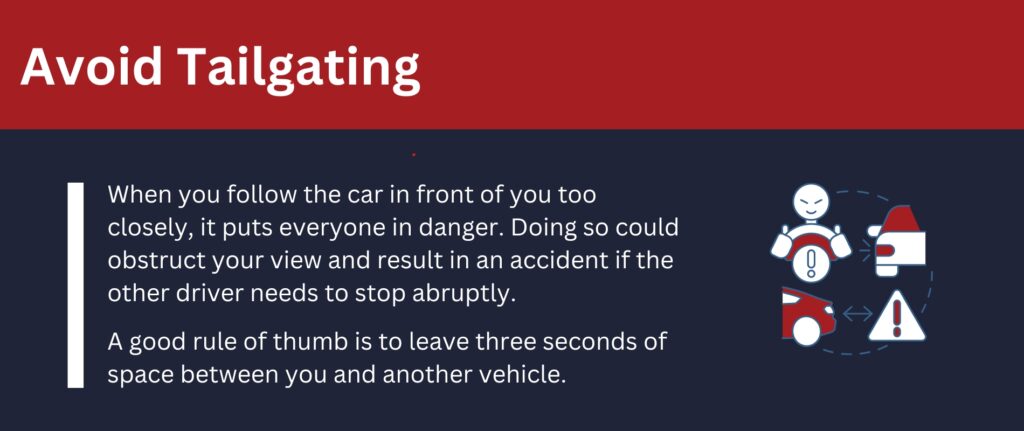
When you tailgate, or follow the car in front of you too closely, it becomes more difficult for you to see the road in front of you since your view is blocked by the vehicle which is in front of you. In addition, if the vehicle in front of you suddenly hits their brakes, you won’t have sufficient time to react.
When following behind another vehicle, you should follow three seconds behind them.
When vehicles merge ahead of you and are too close, you should remove your foot from the gas pedal. This will create space in between yourself and the vehicle ahead of you.
10. Drive Defensively
Defensive driving is driving while anticipating a dangerous situations such as adverse conditions or others’ mistakes. You should always expect the drivers around you to suddenly do the stupidest thing possible and be prepared to react to it.
The practice described in the previous tip, keeping a three-second gap between yourself and the vehicle ahead of you, is an example of defensive driving. Other examples of defensive driving include driving at a safe speed so you have plenty of time to react to things, looking far ahead on the road, watching other drivers, and driving at a safe speed for the weather and roadway conditions.
As many of 56 percent of fatal traffic accidents involve aggressive driving.
11. Accelerate And Brake Smoothly
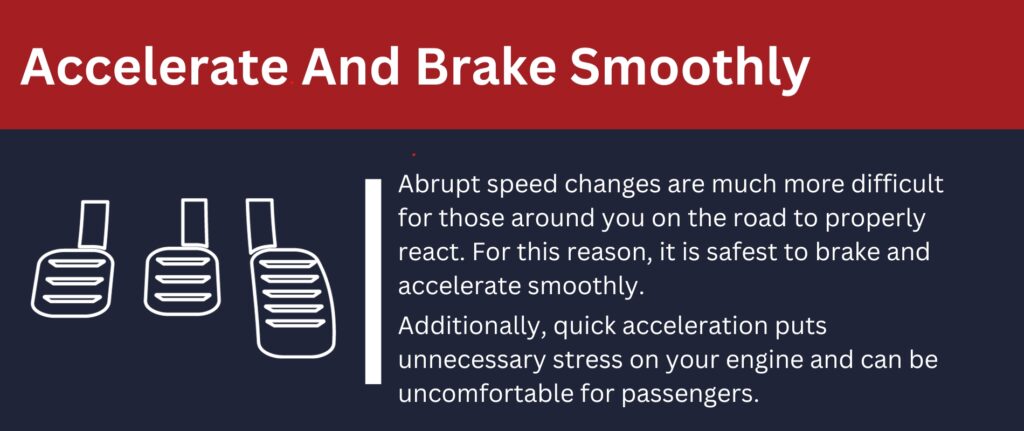
Abrupt speed changes are much more difficult for those around you on the road to properly react to. For this reason, it is safest to brake and accelerate smoothly.
However, there are other reasons to accelerate and brake smoothly. For one, quickly accelerating puts unnecessary stress on your engine. In addition, when you abruptly accelerate or hit the brakes, it can be uncomfortable for your passengers as well as yourself.
12. Be Prepared
Driving trips don’t always go as planned. Sometimes adverse events occur. You should always be prepared for such events.
It’s important to have jumper cables in case your battery dies. You don’t want to be stranded in the cold rain far away from food, water or a bathroom.
You should keep a spare tire along with you. Again, there are certain situations you don’t want to be stranded in, as they could be dangerous.
Keep a first aid kit in your vehicle. Make sure that you always have the proper documents in your vehicle like your vehicle registration and your proof of insurance.
13. Never Drive Intoxicated
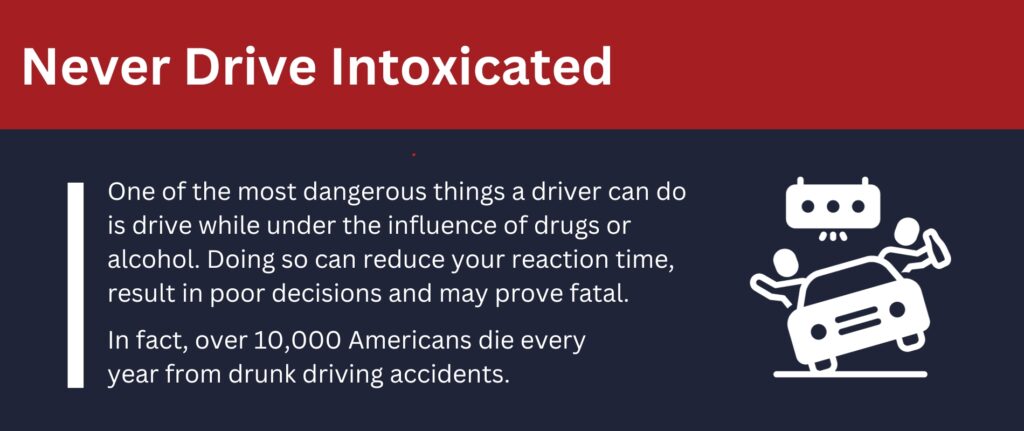
Perhaps the most dangerous thing a driver can do is drive while under the influence of drugs or alcohol. It is very important to drive with a clear mind. Driving while intoxicated can greatly reduce your reaction time as well as cause you to make poor decisions while behind the wheel. Drivers are much more prone to drive aggressively while drunk, and this can prove fatal.
- About 37 Americans die each day in a drunk driving accident
- 11,654 Americans were killed in drunk driving crashes in 2020
If You’re In A Car Accident, Get Legal Help
If you get injured in a car accident that isn’t your fault, the at-fault party’s insurance company will refuse to pay you what you’re entitled to under California law if you don’t have a lawyer. By hiring experienced car accident lawyers like those at Nadrich Accident Injury Lawyers, you send a message to the insurance company that you can sue them and win over a lowball settlement offer.
Contact us today for a free consultation if you or a loved one has been injured or killed in a car accident that wasn’t your fault. We can help you recover compensation for medical bills, lost wages, property damage, pain, suffering, wrongful death and more. We won’t charge you any fee to handle your car accident case until and unless we recover financial compensation on your behalf.
For more tips for beginner drivers, check out our infographic below.


